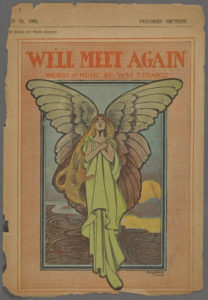William Francis
William T. Francis was a versatile musician and composer who lived in New Orleans in the late nineteenth century.

Courtesy of New York Public Library
We'll Meet Again. Francis, William T. (composer)
William T. Francis, versatile musician and composer, was born in New Orleans in approximately 1867 and was actively working in the city during the last two decades of the nineteenth century. Serving as organist at Trinity Episcopal Church, he composed a large quantity of church music, parlor pieces, and concert works. With his Juvenile Opera Company, he presented a series of performances at the Avenue Theatre. Most of his extant published music consists of piano works in many genres.
Although Francis’s piano music is based on popular forms, his works display an element of virtuosity not associated with predominantly utilitarian music. A fine example of his style is his second “Mazurka de Concert” (1889), the very title of which indicates the intent of the piece. Its rhythm is highly stylized and at times only implies a mazurka, a Polish folk dance in triple meter, usually at a lively tempo, and with accent on the second or third beat. The accompaniment is more thoroughly composed than the typical left-hand waltz pattern, and the melodic material features rapid scales, arpeggios, and double-note passages. His gentler parlor piece, “Les Petites Blondes” (1885), is subtitled “gavotte” and is a stylistically accurate representation of this dance form unique in the repertoire of the New Orleans composers of his time. His rambunctious “March 127” (1884) could easily be mistaken for a march of John Philip Sousa. It evokes the instrumentation of a marching band and contains a well-orchestrated trio section that builds to a rousing climax.
Much of Francis’s music was influenced by the compositions of the Mexican composers who were known in New Orleans. Several pieces are in fact arrangements of these compositions, some simply designated as Mexican melodies and others attributed to the original composers (“Viderique,” “Aviles”). “El Nopal: Danza Mexicana” (1885) is by all indications an original composition of Francis and represents a rhythmic style that was generally avoided by native New Orleans composers. His song “Zozo Mokeur” is a delightful piece that combines operatic and Caribbean characteristics in an allegory of an innocent girl who learns that the song of a nightingale is actually that of a mockingbird hidden in the Spanish moss.
Eventually relocating to New York, Francis became active in operatic comedy or burlesque theater circles both as composer and music director from 1898 to 1912. For works where he served as music director and/or conductor, he frequently added new songs of his own. He was the successor to John T. Stromberg for the Joe Weber and Lee Field Burlesque Company. Francis died in New York in 1912.
